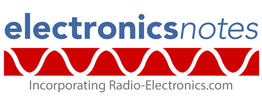Home » Component data » Transistor data » this page
S9013 Transistor Data
Key transistor data for the S9013 audio output transistor including key electrical parameters, pinout, package type and many other key transistor datasheet details.
The S9013 is described as an NPN epitaxial silicon transistor designed for class B push-pull output stages up to 1 watt for portable radios.The 9013 is complementary to the PNP S9012 and it can handle a collector current up to 500mA, despite being encapsulated in a TO92 package.
In some datasheets and parts lists, etc, the devices may also be seen designated as SS9013 rather than the more usual S9013 device, but this is a slightly different part number used by different manufacturers for the same device.
The complementary transistor to the S9013 is the PNP S9012.
Key details and performance parameters for the S9013 transistor.
| S9013 / SS9013 transistor datasheet parameters & data |
|
|---|---|
| Parameters | Details |
| Transistor type | NPN silicon |
| Package type | TO92 |
| VCBO max (V) | 40 |
| VCEO max (V) | 20 |
| VEBOmax (V) | 5 |
| IC max (mA) | 500 |
| TJ Max °C | 150 |
| PTOT mW | 625 |
| fT min (MHz) | 100 MHz min |
| COB | |
| hfe | 64 - 202 @ Ic 50mA - see below |
| IC for hfe | 50mA |
| Similar / equivalents | |
Outline:
Pinout:
S8050 leaded hFE classifications
| S9013 hFE classifications |
|||||
|---|---|---|---|---|---|
| Classifications | S9013D | S9013E | S9013F | S9013G | S9013H |
| hFE | 64 ~ 91 | 78 ~ 112 | 96 ~ 135 | 112 ~ 166 | 144 ~ 202 |
Explanation of transistor parameters
| Parameter | Explanation |
|---|---|
| VCBO Max | Maximum collector-base voltage with emitter open circuit . |
| VCEO Max | Maximum collector-emitter voltage with base open circuit. |
| VEBO Max | Maximum emitter-base voltage with collector open circuit. |
| VCEsat (included where applicable) | The voltage drop across the collector-emitter when the transistor is fully saturated (acting as a closed switch). |
| IC Max | Maximum collector current. |
| Parameter | Explanation |
|---|---|
| TJ | Maximum junction temperature. |
| PTOT Max | Maximum device dissipation normally in free air at 25°C unless other conditions indicated. |
| fT Min | Minimum cutoff frequency at which the current gain in a common emitter circuit falls to unity. |
| COB Max | Maximum collector capacitane, normally measured with emitter open circuit. |
| hFE | DC current gain for HFE at IC. [Note hfe is the small signal gain and although this may be slightly different, the transistor current gain will vary considerably from ne transistor to the next of the same type.] |
| PTOT Max | Maximum device dissipation normally in free air at 25°C unless other conditions indicated. |
These are the main transistor parameters that have been included in our list. There are others, but these help quantify the main elements of the performance of the transistor.
Please note, that the data given is the best estimate we can give within a tabulated summary of this nature. Parameters also vary between manufacturers. Electronics Notes cannot accept any responsibility for errors, inaccuracies, etc, although we do endevaour to ensure the data is as accurate as possible.
Notes and supplementary information
• Availability & sources
The S9013 is available from a number of stockists and electronic component distributors many of which are given in the table below.
S9013 Component Distributor, Stock and Pricing
• S9013 further details
The S9013 was originally manufactured by a number of tier 1 companies and many others .
The S9013 is ideal for many general purpose applications as it has a high gain and general capability, especially a high dissipation capability and this makes it ideal for use in class B output stages.
• Typical output stage
The NPN S9013 and its complementary transistor the PNP S9012 are ideal for being used in a class B or push-pull output stage for a transistor radio.
Push pull output stages are far more efficient when compared to class A ones and this means that smaller transistors with lower maximum heat dissipation figures can be used.
The S9013 is specified as having a relatively high dissipation figure, although I personally would not like to run the transistor at its maximum rating, or even anywhere near it.
However the device is ideal for use in relatively low power output stages like those in a small transistor radio.
The circuit of an typical generic push-pull or class B output stage is given in the diagram. It uses an NPN and a PNP transistor, each handling opposite sides of the waveform.

The input waveform is applied to the base electrodes of both transistors, TR1 and TR2 via the capacitors C1 and C2.
The resistor chain consisting of R1, R2 and R3 provide the biasing for the transistors holding them at just the turn on point, so that one half of the cycle is covered by one transistor and the other half of the cycle is covered by ye other one.
The capacitor C3 is included because most transistor radios using these small output transistors would only have a single voltage rail, i.e. the positive supply and ground.
The junction of the emitters of the two transistors would normally sit at half the supply voltage and therefore any load, in this case a loudspeaker would need to have only the AC signal and no DC included.
 Written by Ian Poole .
Written by Ian Poole .
Experienced electronics engineer and author.
Return to Component Data menu . . .




